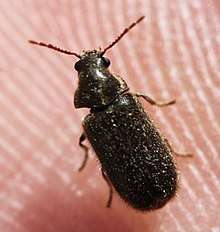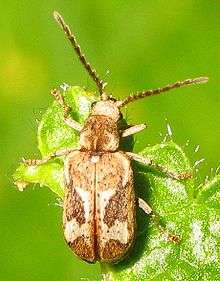Ptinidae
Ptinidae is a family of beetles in the superfamily Bostrichoidea. There are at least 220 genera and 2,200 described species in Ptinidae worldwide.[1] The family includes spider beetles and deathwatch beetles.[2]
| Ptinidae | |
|---|---|
 | |
| Caenocara | |
| Scientific classification | |
| Kingdom: | Animalia |
| Phylum: | Arthropoda |
| Class: | Insecta |
| Order: | Coleoptera |
| Suborder: | Polyphaga |
| Infraorder: | Bostrichiformia |
| Superfamily: | Bostrichoidea |
| Family: | Ptinidae Latreille, 1802 |
| Subfamilies | |
| |
| Diversity | |
| at least 220 genera | |


There are three main groups in the superfamily Bostrichoidea: Bostrichidae, Anobiidae, and Ptinidae. These have undergone frequent changes in hierarchical classification since their inception. They have been treated as a single family, three independent families, the two families Bostrichidae and Anobiidae, or the two families Bostrichidae and Ptinidae. More recent literature treats these as the two families Bostrichidae and Ptinidae, with Anobiidae a subfamily of Ptinidae (Anobiinae).[3][4][5][6][2]
Spider beetles are so named because they look like spiders. Some species have long legs, antennae that can seem like an additional pair of legs, and a body shape that may appear superficially like that of a spider.
Deathwatch beetles are named because of a clicking noise that two (and possibly more) species tend to make in the walls of houses and other buildings. This clicking noise is designed to communicate with potential mates, but has historically caused fear of impending death during times of plague and sickness.
Pests
The larvae of a number of Ptinidae species tend to bore into wood, earning them the name "woodworm" or "wood borer". Several species are pests, causing damage to wooden furniture, house structures, tobacco, and dried food products. The deathwatch beetles Xestobium rufovillosum, Hemicoelus carinatus, and Hemicoelus gibbicollis are economically significant pests, damaging flooring, joists, and other timber in housing.
The "furniture beetle", Anobium punctatum, is a species that is often found emerging from in-home wood furnishings. The "drugstore beetle", Stegobium paniceum, is known to infest a variety of stored materials, including bread, flour, cereal, prescription drugs, strychnine powder, packaged foods, and even Egyptian tombs.
The "Cigarette beetle," Lasioderma serricorne, is a widespread and destructive pest of harvested and manufactured tobacco. Damage and economic losses from L. serricorne infestations were estimated by the USDA to be 0.7% of the total warehoused tobacco commodity in 1971.[6]
See also
References
- "Ptinidae". GBIF. Retrieved 2018-08-27.
- "Ptinidae Family Information". BugGuide.net. Retrieved 2018-08-27.
- Bell, Karen Leanne; Philips, T. Keith (2011). "Molecular systematics and evolution of the Ptinidae (Coleoptera: Bostrichoidea) and related families" (PDF). Zoological Journal of the Linnean Society. 165: 88–108. doi:10.1111/j.1096-3642.2011.00792.x.
- Löbl, Ivan; Smetana, Aleš (2007). Lobl, I.; Smetana, A. (eds.). Catalogue of Palaearctic Coleoptera. Volume 4: Elateroidea - Derodontoidea - Bostrichoidea - Lymexyloidea - Cleroidea - Cucujoidea. doi:10.1163/9789004260894. ISBN 978-87-88757-67-5.
- Bouchard, Patrice; Bousquet, Yves; Davies, Anthony E.; Alonso-Zarazaga, Miguel A.; et al. (2011). "Family-group names in Coleoptera (Insecta)". ZooKeys (88): 1–972. doi:10.3897/zookeys.88.807. ISSN 1313-2989. PMC 3088472. PMID 21594053.
- Arango, Rachel A.; Young, Daniel K. (2012). "Death-watch and spider beetles of Wisconsin (Coleoptera: Ptinidae)" (PDF). General Technical Report FPL-GTR-209.
Further reading
- Arnett, R.H. Jr.; Thomas, M. C.; Skelley, P. E.; Frank, J. H., eds. (2002). American Beetles, Volume II: Polyphaga: Scarabaeoidea through Curculionoidea. CRC Press. ISBN 978-0849309540.
- Borowski, Jerzy; Wegrzynowicz, Piotr (2007). World Catalogue of Bostrichidae (Coleoptera). Wydawnictwo Mantis. ISBN 9788392618218.
- Bouchard, P.; Bousquet, Y.; Davies, A.; Sikes, D. (2013). "Checklist of beetles (Coleoptera) of Canada and Alaska". ZooKeys (2nd ed.) (360): 1–44. doi:10.3897/zookeys.360.4742. PMC 3867111. PMID 24363590.
- Crotch, G.R. (1873). Check list of the Coleoptera of America, north of Mexico. Naturalists' Agency. doi:10.5962/bhl.title.38811. ISBN 978-0665070778.
- LeConte, J.L. (1861). Classification of the Coleoptera of North America. Smithsonian Miscellaneous Collections. 3. Smithsonian Institution. doi:10.5962/bhl.title.38459. ISBN 978-0665100550.